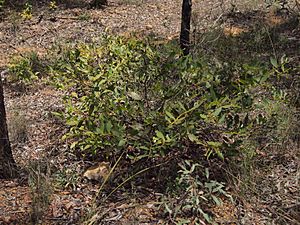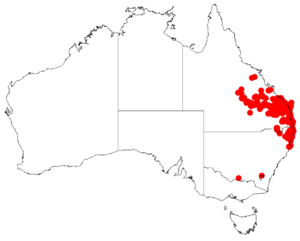Acacia complanata facts for kids
Quick facts for kids Acacia complanata |
|
|---|---|
 |
|
| Scientific classification | |
| Genus: |
Acacia
|
| Species: |
complanata
|
 |
|
| Occurrence data from AVH | |
| Synonyms | |
|
|
Acacia complanata, also called the long-pod wattle or flat-stemmed wattle, is a type of tree or large bush that lives for many years. It grows naturally in eastern Australia.
What Does the Long-Pod Wattle Look Like?
This plant can grow as a tree, reaching about 5 to 6 meters (16 to 20 feet) tall. However, it is more often seen as a large shrub. Its branches are smooth (glabrous), bendy (flexuose), flat, and have narrow wings.
Like most Acacia plants, it has special leaf-like parts called phyllodes instead of true leaves. These phyllodes are always green. They are shaped like a narrow oval, usually 5 to 10 centimeters (2 to 4 inches) long and 12 to 30 millimeters (about 0.5 to 1.2 inches) wide. Each phyllode has seven to nine main lines or veins that stand out.
The flowers grow in groups of four to eight. These groups appear where the leaf-like parts meet the stem (called the axil). Each flower-head is round, about 6 millimeters (0.24 inches) across. They contain 35 to 45 golden-colored flowers.
After the flowers bloom, long, thin seed pods form. These pods are rounded over each seed inside. The pods are wrinkled and smooth, growing up to 15 centimeters (6 inches) long and 7.5 to 10 millimeters (0.3 to 0.4 inches) wide. The dark brown seeds inside are almost round and are 4 to 5 millimeters (0.16 to 0.2 inches) long.
The long-pod wattle is not considered an endangered plant. It is often used in projects that help manage and protect the environment.
How Scientists Name This Plant
The first time this plant was officially described by a scientist was in 1842. A botanist named George Bentham wrote about it. This was part of a larger work by William Jackson Hooker.
Later, in 1987, another botanist named Leslie Pedley put it into a different group, calling it Racosperma complanatum. But in 2006, it was moved back to the Acacia group.
The second part of its scientific name, complanata, comes from the Latin word complano. This word means flattened. It refers to the flat shape of the plant's stems. There is also one known type of this plant called Acacia complanata var. fasciculata.
Where Does the Long-Pod Wattle Grow?
This shrub is found in many places across south-eastern Queensland, Australia. You can see it from areas like Jericho in the west to Bundaberg in the east. It also grows further south into New South Wales, reaching as far as the Dumaresq River and down the north coast near Coffs Harbour.
It usually grows on low hills. It prefers gravelly, sandy, or loamy soils, often found over sandstone. You will often find it in areas of heathland (open land with small shrubs) or dry sclerophyll forest (forests with tough, dry leaves). It often grows as part of the understorey (the plants that grow beneath the main trees) in forests. These forests are usually dominated by trees like Eucalyptus racemosa or Corymbia citriodora.

